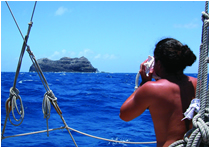The Naming of Papahānaumokuākea
 For Native Hawaiians, place names are an important way to preserve information about an area’s geology, its history, natural and supernatural phenomenon specific to it, or its uses by gods and men. As a place changes over time, so may its name. Historically, Native Hawaiians referred to the Northwestern Hawaiian Islands as Nā Moku Manamana (Branching Islands), Nā Moku Papapa (Flat Islands) and nā papa kahakukea o Lono (the lowwhite-marked isles of Lono (one of the four principal Hawaiian gods) (Kepā Maly 2 November 2008, personal communication; Fornander 1918). In recent times, Native Hawaiians have called the isles of this region the Kūpuna (Revered Elder) Islands. The name Papahānaumokuākea was given to the region by a group of Native Hawaiian cultural practitioners and kūpuna when the area was designated as a national marine monument. The name specifically relates to one of the stories contained within the Kumulipo: the mo‘olelo which tells the story of Papahānaumoku (a mother figure who is personified in the earth) and Wākea (a father figure who is personified in the expansive sky). These two figures, either together or separately, are responsible for the creation or birthing of the entire archipelago, and they are the most recognized ancestors of the Native Hawaiian people (Beckwith 1951, Malo 1951, Fornander 1918). The name Papahānaumokuākea is reflective of the region’s natural and cultural heritage and its future as a vast, sacred, protected and procreative place. The preservation of these names, together, as Papahānaumokuākea, strengthens Hawai‘i’s cultural foundation and grounds Hawaiians to an important part of their historical past. Taken apart, “Papa” (earth mother), “hānau” (birth), “moku” (small island or land division), and “ākea” (wide) bespeak a fertile woman giving birth to a wide stretch of islands beneath a benevolent sky, the dramatic imagery of which is on full display in the region.
For Native Hawaiians, place names are an important way to preserve information about an area’s geology, its history, natural and supernatural phenomenon specific to it, or its uses by gods and men. As a place changes over time, so may its name. Historically, Native Hawaiians referred to the Northwestern Hawaiian Islands as Nā Moku Manamana (Branching Islands), Nā Moku Papapa (Flat Islands) and nā papa kahakukea o Lono (the lowwhite-marked isles of Lono (one of the four principal Hawaiian gods) (Kepā Maly 2 November 2008, personal communication; Fornander 1918). In recent times, Native Hawaiians have called the isles of this region the Kūpuna (Revered Elder) Islands. The name Papahānaumokuākea was given to the region by a group of Native Hawaiian cultural practitioners and kūpuna when the area was designated as a national marine monument. The name specifically relates to one of the stories contained within the Kumulipo: the mo‘olelo which tells the story of Papahānaumoku (a mother figure who is personified in the earth) and Wākea (a father figure who is personified in the expansive sky). These two figures, either together or separately, are responsible for the creation or birthing of the entire archipelago, and they are the most recognized ancestors of the Native Hawaiian people (Beckwith 1951, Malo 1951, Fornander 1918). The name Papahānaumokuākea is reflective of the region’s natural and cultural heritage and its future as a vast, sacred, protected and procreative place. The preservation of these names, together, as Papahānaumokuākea, strengthens Hawai‘i’s cultural foundation and grounds Hawaiians to an important part of their historical past. Taken apart, “Papa” (earth mother), “hānau” (birth), “moku” (small island or land division), and “ākea” (wide) bespeak a fertile woman giving birth to a wide stretch of islands beneath a benevolent sky, the dramatic imagery of which is on full display in the region.
